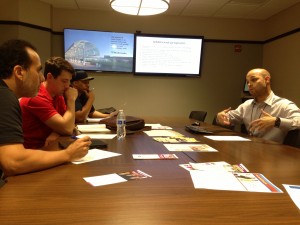An Answer to Cancer Audit
For our field project, our team, An Answer to Cancer, supported the Rush-Copley Cancer Care Center through a fundraising event and volunteer service event in effort to promote cancer awareness and generate revenue in support of the fight against cancer. The events were as follows:
Making Strides of Fox Valley 5k Walk: Sunday, October 18, 2015 at Pottawatomie Park in Saint Charles, IL
Support the Cure: Friday, October 23, 2015 at The James Joyce Irish Pub in Berwyn, IL
 Project Description
Project Description
The team first met on September 18, 2015 to choose our field project. Of the six different charities we all brainstormed, we decided to choose one that made an impact on our lives in some form. Our final selection was a charity that promoted cancer awareness. The team figured the timing was ideal to raise awareness towards such a cause since September was Childhood Cancer Awareness Month, October was National Breast Cancer Awareness Month, and November is Lung Cancer Awareness Month. With the help of Doug’s connections at Rush-Copley Cancer Care Center, we were able to get kickoff this project and meet with key staff members at the center. On September 24, 2015, the team had their first visit to the center and met with Ryan Alvarez. As the Business Manager who supports the operations and programming of the center, Ryan was very insightful with explaining the services this organization offers to the community and its members. In addition, he provided us with a list of the Rush-Copley Charitable Funds that we could choose to support. After careful analysis, we selected the Waterford Place Cancer Resource Center. Our group was very fortunate to have an individual so passionate about his job and the mission to support and promote cancer awareness efforts.
Charity Description
According to the American Cancer Society, approximately “1,658,370 new cancer cases will be diagnosed in 2015”. About “589,430 Americans are expected to die of cancer in 2015”. However, according to The World Health Organization, “40% of all cancer deaths can be prevented”. With such alarming statistics, our team decided to raise revenue to benefit the Waterford Place Cancer Resource Center at Rush-Copley. The mission of Waterford Place is to compassionately connect with and offer support, guidance and resources to people with cancer and those that care for them. Waterford Place is a home away from home for cancer patients, survivors, and caregivers by providing a variety of support services including counseling, support groups, free integrated health treatments, stress management classes, and educational programming to improve health outcomes and emotional well-being. We all understood the hardship and difficulty cancer can be for the patient and their loved ones which was one of the group’s main motivation to support the development of a facility that will provide the community a space for physical and spiritual reflection. Simply put, “Waterford Place is where help meets hope.”
Project Objectives and Outcomes
In support of our chosen charity, the group decided on two events:
 The first one was a service event to assist as volunteers at the “Making Strides Against Breast Cancer” 5k walk on October 18, 2015. At this event we worked with the American Cancer Society to collect petition signatures requesting Congress to continue funding cancer research. This event allowed us to interact with community members that supported the fight against cancer. In addition, we utilized this opportunity to promote our main event, “Support the Cure”. The walk was a huge success; with 76 teams and 909 participants, the event raised a total of $88,196.68.
The first one was a service event to assist as volunteers at the “Making Strides Against Breast Cancer” 5k walk on October 18, 2015. At this event we worked with the American Cancer Society to collect petition signatures requesting Congress to continue funding cancer research. This event allowed us to interact with community members that supported the fight against cancer. In addition, we utilized this opportunity to promote our main event, “Support the Cure”. The walk was a huge success; with 76 teams and 909 participants, the event raised a total of $88,196.68.
Our main event took place on October 23, 2015 at the James Joyce Irish Pub. “Support the Cure” was a social gathering event that our group hosted in efforts to raise funds to support our charity through ticket and raffle sales. Our goal was to generate profit with minimum overhead cost which was possible thanks to The James Joyce Irish Pub who worked with us to ensure a successful event. As a group, we decided that in order to keep overhead cost at a minimal, we would have to seek donations from local businesses. Fortunately, Rush-Copley was able to provide us with a letter stating their tax-exempt status as a nonprofit charitable organization. Using this letter, we were able to collect donations of all food items and raffle prizes towards our event.
Our goal was to raise revenue of $1500 or greater through the combination of on-line donations, ticket sales for our main event “Support the Cure”, and in-kind donations. Our actual amounts were as follows:
Net Cash Donations: $852.00
In-Kind Donations: $1,199.00
Total Collected Value Towards Fundraising Efforts: $2,051.00
Although our ultimate goal was to raise $1500 in cash donations for Rush-Copley Cancer Care Center, we still managed to exceed our original target when we combine collected revenue with in-kind donations.
Lessons Learned
Managing project teams
As a group we met all of the conditions of a high performing team. First order of business was to create a team atmosphere. We selected our project manager who served as the coach of the team. Team members also volunteered for different assignments and other times our project manager assigned task. Every team member was responsible for a specific task and we trusted that everyone met their objectives. We all shared the same vision once making a decision on which charity to go with. Our team did a great job of taking advantage of everyone’s strength. For example, using certain team member’s social media skills was an effective way to promote our charity and event via Facebook. As a group I think we have all been able to grasp a great understanding of the material covered in chapter 11 – managing project teams.
Developing a project plan
In order to get the finish line there must be a drawn out route to get there. Developing a project plan is key to the success of our project. There are different techniques you can use to map out your plans. For our project we used the critical path method. The team knew the task that needed to be completed before the next event can occur. For example we set up our donations page prior to being able to post the link on our Facebook page. I believe all the techniques described in chapter 6 can be applied to any project whether it’s for your company or a home project. AOA or AON is a great way to track and measure lead times on activities to arrive at an accurate ETA for completion.
Communication
The method of communication used by the group was primarily email, text messaging, and phone conferencing. Our project manager touched base with team members almost daily to gather updates, set reminders, and provide assistance if needed.
Advice
As a reflection on the past 8 weeks, the key piece of advice we would recommend for future teams is to thoroughly develop a well defined plan and prepare for the unexpected. We were given a very limited timeline from start to finish but our team completed both events in under 6 weeks. This would not have been possible if we did not identify the critical path and prioritize the activities that needed to be completed before proceeding to the next step. Developing a detailed project plan that listed all the activities and who they were assigned to was an effective method to ensure we met our project goals. In addition, ensure that you include a contingency plan should any unexpected circumstance occur. Our team faced that situation in the process of requesting donations from local businesses. We established a backup plan that included a contribution from every team member in the worst case scenario. The combination of persistent team members and supportive local businesses helped us achieve our goal and we held a successful event.
This field project was a great experience and opportunity for us to meet and network with other people in support of a great cause!








